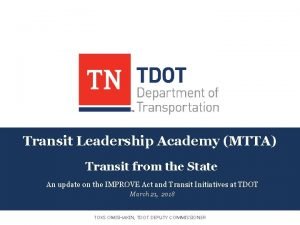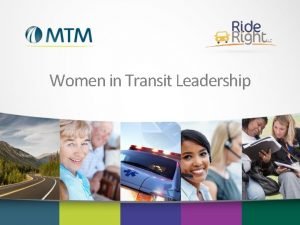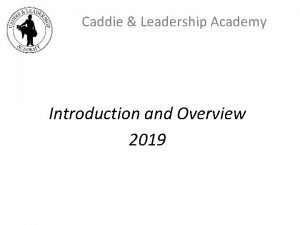Transit Leadership Academy MTTA Transit from the State
















- Slides: 16

Transit Leadership Academy (MTTA) Transit from the State An update on the IMPROVE Act and Transit Initiatives at TDOT March 21, 2018 TOKS OMISHAKIN, TDOT DEPUTY COMMISSIONER

IMPROVE Act: Transportation All projects complete, under construction, or under contract by 40% Increase for Local Transportation Needs $35 M additional for cities $70 M additional for counties $245 M additional for state 2030

IMPROVE Act: 962 Projects Improving 1, 300 Miles of Tennessee Roads

IMPROVE Act FY 2018 -20 – 3 Year Plan IMPROVE Act: 962 Projects 3 Year Plan: 101 Projects Pre- IMPROVE Act Projects Region 1 Region 2 Region 3 Region 4 IMPROVE Act : 95 Counties 3 Year Plan : 40 Counties 20% 40% IMPROVE Act : Urban vs. Rural (52%/48%) 3 Year Plan : Urban vs. Rural (67%/33%) 24% 16% New Starts by Region 2 7 14 Region 1 Region 2 Region 3 Region 4 15 3 Year Plan • 62 Backlog Project moving forward • 38 New Start Projects 3 Year Plan(Miles per Region) • Region 1, 147. 3 miles • Region 2, 159. 7 miles • Region 3, 113. 9 miles • Region 4, 81. 7 miles

IMPROVE Act: Transportation Transit Plan Details 1. Local Option – Referendum 2. 12 counties in TN eligible 3. Limited to 6 taxes (sales tax, business tax, car rental tax, hotel/motel tax, residential development tax and wheel tax). 4. Comptroller Review/Approval 5. 40% TDOT Transit Program – Proportional Increase for Local Transportation Needs increase (33% increase in state transit dollars)

IMPROVE Act: Transportation Transit Plan Details Statewide Mobility Transit Grant 1. Capital in nature (Bus stops, transit stations/facilities, buses, ITS projects, dedicated transit ways, etc. ) 2. Statewide Transportation Network 3. Regional Connectivity (multi-county impact) 4. Economic Development goals (access to employment) 5. Balanced investments – large urban, small urban, and 40% Increase for Local Transportation Needs rural transit systems

IMPROVE Act Local Option Opportunity

TDOT’s Role in Transit • Administer the Federal Program (FTA) • Partner in Funding (Federal and State) • Partner in Planning and Projects (Corridor Studies, Long Range Plans) • Lead Regional Transit programs (i. e. Swipe and Ride, Park and Ride)

IMPROVE ACT AWARDS SFY 2018 Applicant Project Description Murfreesboro: Transit Facility Comprehensive transit facility for passengers. Nashville MTA: Bus Replacement Purchase of 7 hybrid 40 ft buses to replace diesel buses. NWTHRA: Transit Center Transit facility for admin staff, dispatch, training, maintenance, and operations. UCHRA: Transit Center Comprehensive transit facility for passengers, admin staff, maintenance, and operations. Nashville RTA: Rail Vehicles Overhaul 1 locomotive and rebuild the trucks, replace the shocks and bushings, and remove rust on cars. CARTA: Mobility as a Service Phase I Neighborhood on-demand service using smaller vehicles with mobile ticketing system and real-time arrival technology. MATA: Electronic Fare Collection Upgrade 1992 cash fare collection system to digital mobile ticketing smart card technology. Johnson City: Transit Facility Improvements Replace 1985 HVAC system in the downtown transit terminal with new energy efficient HVAC system. Knoxville: Bus Lift for Maintenance Replace in-ground hydraulic bus lift systems. Nashville RTA: Coach Buses Purchase 5 coach buses to be operated by regional commuter bus operator. Clarksville: Digital Radio Conversion Replace short-range analog hand-held radios in all buses with vehiclemounted long-range digital radios that allow multiple users at one time. Jackson: Bus Camera System Installation of safety and security digital cameras on all active buses with audio/visual features.

Moving Transit Forward • 2015 Tennessee Transit Study (Existing and Future needs, Performance Measures) • Supportive Transit Infrastructure (Design, Policy) • Regional Connectivity (Linkages to the major destinations, employment hubs)

Tennessee Growth INCREASE IN TOTAL JOB GROWTH BY REGION - 2015 TO 2040 Northwest 22% Delta Southwest 42% 29% Middle Tennessee Upper Cumberla nd 59% South Central 29% 34% East Tennessee Tri Cities 42% 44% Southeast 28% Increase in Job Growth POPULATION GROWTH - 2015 TO 2040 IF NO CHANGES ARE MADE IN FUNDING, THE NUMBER OF TRANSIT TRIPS PERSON IN THE STATE OF TENNESSEE WILL BE CUT IN HALF BY THE YEAR 2035. 5

Tennessee TRANSIT Gaps

RURAL FOCUSED NEED NASHVILLE URBAN FOCUSED NEED KNOXVILLE CONGESTION IN TENNESSEE IN 2010 Congestion CONGESTION IN TENNESSEE IN 2040 TRANSIT DEPENDENCY INDEX Incomplete Data Low Congestion Medium High MEMPHIS 9 CHATTANOOGA TRANSIT DEPENDENCY INDEX TRANSPORTATION CAPACITY DEFICIENCY INDEX The Transit Dependency Index considers demographic data and is most useful to assess “safety net” transportation need. Those needing those types of transportation services include the population over 65; carless households; population living in poverty; and population under 65 with a disability. It does not address where transit need is determined by other “push” factors, such as congestion, a wish for a community to improve or maintain its “quality of life” by introducing a robust transit system, or other environmental considerations. The Transportation Capacity Deficiency Index addresses issues of congestion and pollution. Together, the combination of both indices highlight the need in both rural and urban areas to create more transit options for the citizens of Tennessee.

Top 5 Transportation Priorities for TN Over the Next 25 Years By Group Rank 1 2 3 4 5 Residents Partners Elected Officials Maintaining Existing Highways Relieving Congestion Building New Highways Relieving Congestion Addressing Commercial Truck Traffic Expanding Public Transportation Addressing Mobility Needs for Seniors Expanding Public Transportation Addressing Commercial Truck Traffic A total of 2, 729 surveys were completed; response rate of nearly 35% A total of 454 Partner surveys were completed; response rate of slightly over 50% A total of 333 Elected Official surveys were completed; response rate of 62% 2013 -2014 Statewide Customer Service Survey - TDOT Expanding Public Transportation Adding Shoulders


Transit Leadership Academy (MTTA) Transit from the State An update on the Improve Act and Transit Initiatives at TDOT March 21, 2018 TOKS OMISHAKIN, TDOT DEPUTY COMMISSIONER
 Mtta academy
Mtta academy Mtm transit maintenance
Mtm transit maintenance Washington state transit insurance pool
Washington state transit insurance pool Willamette leadership academy
Willamette leadership academy Aacte leadership academy
Aacte leadership academy Diversity executive leadership academy
Diversity executive leadership academy Jubilee leadership academy
Jubilee leadership academy Toyota leadership academy
Toyota leadership academy Breakthrough coaching and leadership academy
Breakthrough coaching and leadership academy Caddie and leadership academy
Caddie and leadership academy Jubilee lead academy
Jubilee lead academy Nisd leadership academy
Nisd leadership academy Atlantis leadership academy
Atlantis leadership academy London leadership academy
London leadership academy Jubilee leadership academy
Jubilee leadership academy Balanced man program
Balanced man program Transformational vs transformative leadership
Transformational vs transformative leadership






























